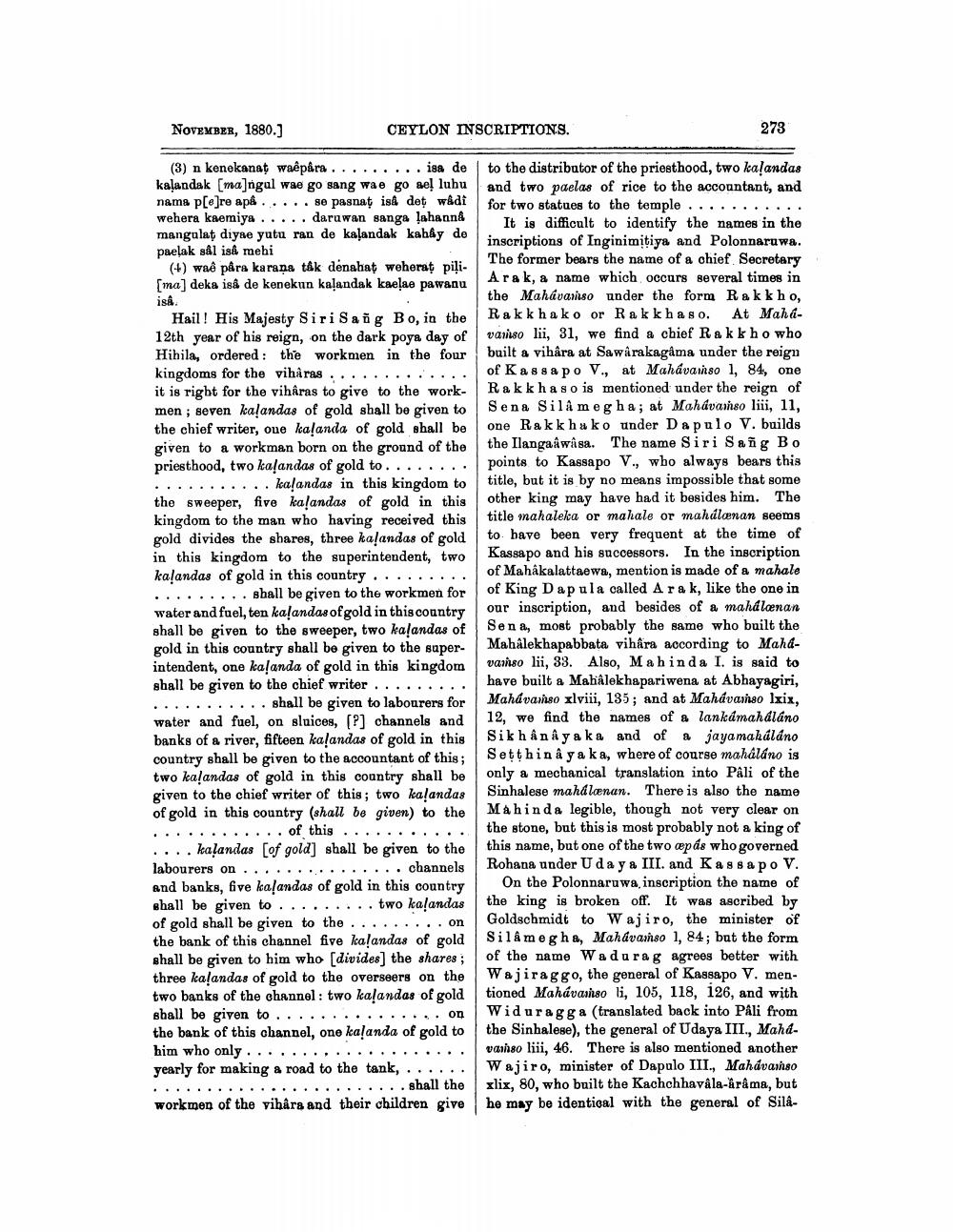________________
NOVEMBER, 1880.]
CEYLON INSCRIPTIONS.
273
(3) n kenekanat waêpara ......... isa de kalandak (ma]ngal wae go sang wae go aeļ luhu nama p[e]re apa ..... se pasnat iså det wadi wehera kaemiya ..... daruwan sanga lahanna mangulat diyae yutu ran de kalandak kahay de paelak sal is& mehi
(+) wað pâra karana tak denahat weherat pili[ma] deka iså de kenekun kalandak kaelae pawanu iså.
Hail! His Majesty Siri Sang Bo, in the 12th year of his reign, on the dark poya day of Hihila, ordered the workmen in the four kingdoms for the vihả ras ............. it is right for the vihậras to give to the workmen; seven kalandas of gold shall be given to the chief writer, oue kalanda of gold shall be given to a workman born on the ground of the priesthood, two kalandas of gold to ........ ........... kalandas in this kingdom to the sweeper, five ka!andas of gold in this kingdom to the man who having received this gold divides the shares, three kalandas of gold in this kingdom to the superintendent, two kalandas of gold in this country ......... ......... shall be given to the workmen for water and fuel, ten kalandas of gold in this country shall be given to the sweeper, two kalandas of gold in this country shall be given to the superintendent, one kalanda of gold in this kingdom shall be given to the chief writer ......... ........... shall be given to labourers for water and fuel, on sluices, (?) channels and banks of a river, fifteen kalandas of gold in this country shall be given to the accountant of this; two kalandas of gold in this country shall be given to the chief writer of this; two ka!andas of gold in this country (shall be given to the ............ of this ........... .... kalandas (of gold] shall be given to the labourers on ................ channels and banks, five kalandas of gold in this country shall be given to ......... two ka!andas of gold shall be given to the ......... on the bank of this channel five ka!andas of gold shall be given to him who [divides] the shares ; three kalandas of gold to the overseers on the two banks of the channel: two kalandas of gold shall be given to ....
...... on the bank of this channel, one kalanda of gold to him who only .................... yearly for making a road to the tank, ......
::.............. shall the workmen of the vihậrs and their children give
to the distributor of the priesthood, two kalandas and two paelas of rice to the accountant, and for two statues to the temple ...........
It is difficult to identify the names in the inscriptions of Inginimitiya and Polonnaruwa. The former bears the name of a chief Secretary Arak, a name which occurs several times in the Mahávarso under the form Rakkho, Rakkha ko or Rakk haso. At Mahavarisolii, 31, we find a chief Ra k k ho who built a vihara at Sawarakagama under the reign of Kassapo V., at Mahávanso 1, 84, one Rak khaso is mentioned under the reign of Sena Silå megha; at Mahdvanso liii, 11, one Rakkha ko under Dapulo V. builds the Ilanga kwasa. The name Siri Sang Bo points to Kassapo V., who always bears this title, but it is by no means impossible that some other king may have had it besides him. The title mahaleka or mahale or mahdlanan seems to have been very frequent at the time of Kassapo and his successors. In the inscription of Mahakalattaewa, mention is made of a mahale of King Dapula called A rak, like the one in our inscription, and besides of a mahdlanan Sena, most probably the same who built the Mahålekhapabbata vihâra according to Mahavarnso lii, 33. Also, Mahinda I. is said to have built a Mabalekhapariwena at Abhayagiri, Mahávanso xlviii, 135; and at Mahávanso lxix, 12, we find the names of a lankámahdlano Sikh ån A ya ka and of a jaya mahdlano Setthin a ya ka, where of course mahaláno is only a mechanical translation into Pâli of the Sinhalese mahdlanan. There is also the name Mahinda legible, though not very clear on the stone, but this is most probably not a king of this name, but one of the two æpás who governed Rohana under Uday a III. and Kassapo V.
On the Polonnaruwa inscription the name of the king is broken off. It was ascribed by Goldschmidt to Wajiro, the minister of Silê megha, Mahávanso 1, 84; but the form of the name Wa darag agrees better with Wajiraggo, the general of Kassapo V. mentioned Mahávanso li, 105, 118, 126, and with Widuragga (translated back into PAli from the Sinhalese), the general of Udaya III., Mahdvanso liii, 46. There is also mentioned another Wajiro, minister of Dapulo III., Mahávaíso xlix, 80, who built the Kachchhavála-Arama, but he may be identical with the general of Sils




